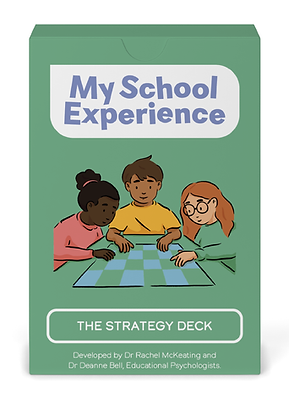How They Work
My School Experience:
Strengths & Needs Deck
The My School Experience Strengths and Needs deck is designed for Educational Psychologists, SENCOs, pastoral staff, learning mentors and more to gather insights from children aged 5-12 years old about their experiences and perceptions of school.
The cards focus on the four areas of need outlined in the SEN Code of Practice (Communication and Interaction, Cognition and Learning, Social Emotional and Mental Health, and Physical and Sensory) and include categories for strengths and difficulties. Each card has an age-appropriate illustration to help children understand its meaning.
The activity provides a structured yet engaging way to gain insights into a child’s school experience. The responses will help adults identify key areas of need and inform actionable, child-centred recommendations for teachers and parents.

Deck Components
1. Card Categories:
-
Strengths Cards: Positive aspects the child feels they are good at or enjoys.
-
Difficulties Cards: Challenges the child experiences or dislikes at school.
-
‘Like me’, ‘Not Like me’ and 'Sometimes Like Me' cards
-
‘?’ Cards: To encourage the child to share other experiences not covered in the strengths and difficulties cards.
2. Areas of Focus:
-
Communication and Interaction (e.g., talking to teachers, making friends) - green cards
-
Cognition and Learning (e.g., reading, maths, problem-solving) - blue cards
-
Social Emotional and Mental Health (e.g., feeling calm, dealing with worries) - pink cards
-
Physical and Sensory (e.g., using tools, feeling comfortable in the school environment - orange cards
Instructions
1. Setup:
-
Explain to the child that each card represents something about school.
-
Lay out the ‘Like me’ and ‘Not like me’ cards.
2. Sorting:
-
Present each Strength and Difficulty card to the child and ask them to place the cards under the ‘Like me’ or ‘Not like me’ card.
-
Provide a ‘Sometimes’ option if appropriate. If the child is uncertain, put the card aside.
-
Use the ‘?’ card to encourage the child to share other experiences not covered in the strengths and difficulties cards.
3. Discussion:
-
Discuss the sorted cards, focusing on the child’s choices.
-
Ask follow-up questions like, ‘Can you tell me more about this card?’ or ‘What helps you with this difficulty?’
4. Recommendations:
-
Use the sorted cards and the child’s explanations to develop tailored recommendations for supporting their needs and building on their strengths at school.
My School Experience:
The Strategy Deck
The My School Experience Strategy Deck is designed for Educational Psychologists, SENCOs, pastoral staff, learning mentors and more to work collaboratively with children aged 5-12 years old to identify strategies or interventions that could support their needs.
Each card includes a specific strategy under one of the four areas of need outlined in the SEN Code of Practice (Communication and Interaction, Cognition and Learning, Social Emotional and Mental Health, and Physical and Sensory). Children can indicate if they would find a particular strategy ‘Helpful’ or ‘Not Helpful’ empowering them to shape the support they recieve. An additional column is made under the card ‘Top 5 Strategies’. Each card has an age-appropriate illustration to help children understand its meaning.
The activity provides a structured yet engaging way to gain insights into the strategies and interventions a child finds helpful which will help inform actionable, child-centred recommendations for staff and parents.

Deck Components
Card Categories:
Strategy Cards relating to the following areas of focus:
-
Communication and Interaction (e.g., having instructions repeated) - green cards
-
Cognition and Learning (e.g., giving examples, hands-on learning) - blue cards
-
Social Emotional and Mental Health (e.g., help to develop friendships) - pink cards
-
Physical and Sensory (e.g., help with using tools, movement breaks) - orange cards
‘Helpful and ‘Not Helpful’ Cards. Provide a ‘Sometimes’ option if appropriate. If the child is uncertain, put the card aside.
’Top 5 Strategies’ Card.
‘?’ Cards: To encourage the child to share other experiences not covered in the strengths and difficulties cards.
Instructions
1. Setup:
-
Choose the cards most relevant for that child in advance.
-
Explain to the child that each card represents a strategy or way that adults can help children in school.
-
Lay out the ‘Helpful’ and ‘Not Helpful’ cards.
2. Sorting:
-
Present each strategy card to the child and ask them to place the card beneath either the ‘Helpful’ or ‘Not Helpful’ card.
-
Provide a ‘Sometimes’ option if appropriate. If the child is uncertain, put the card aside.
-
Use the ‘?’ cards to encourage the child to share other strategies they may find helpful.
3. Discussion:
-
Discuss their preferences to understand what they feel would help them most.
-
Ask follow-up questions like ‘Can you tell me more about this card’ or ‘How does this help’.
-
Ask the child to choose their ‘Top 5 Strategies’.
4. Recommendations:
-
Use their choices to design a personalised support plan.
This activity encourages collaboration and empowerment, giving children a voice in their support strategies.









